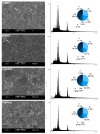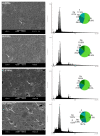Effect of Biosilicate® Addition on Physical-Mechanical and Biological Properties of Dental Glass Ionomer Cements
- PMID: 37367266
- PMCID: PMC10299142
- DOI: 10.3390/jfb14060302
Effect of Biosilicate® Addition on Physical-Mechanical and Biological Properties of Dental Glass Ionomer Cements
Abstract
This study investigated the influence of incorporating Biosilicate® on the physico-mechanical and biological properties of glass ionomer cement (GIC). This bioactive glass ceramic (23.75% Na2O, 23.75% CaO, 48.5% SiO2, and 4% P2O5) was incorporated by weight (5%, 10%, or 15%) into commercially available GICs (Maxxion R and Fuji IX GP). Surface characterization was made by SEM (n = 3), EDS (n = 3), and FTIR (n = 1). The setting and working (S/W time) times (n = 3) and compressive strength (CS) were analyzed (n = 10) according to ISO 9917-1:2007. The ion release (n = 6) was determined and quantified by ICP OES and by UV-Vis for Ca, Na, Al, Si, P, and F. To verify cell cytotoxicity, stem cells from the apical papilla (SCAP) were exposed to eluates (n = 3, at a ratio of 1.8 cm2/mL) and analyzed 24 h post-exposure. Antimicrobial activity against Streptococcus mutans (ATCC 25175, NCTC 10449) was analyzed by direct contact for 2 h (n = 5). The data were submitted for normality and lognormality testing. One-way ANOVA and Tukey's test were applied for the working and setting time, compressive strength, and ion release data. Data from cytotoxicity and antimicrobial activity were submitted for Kruskal-Wallis' testing and Dunn's post hoc test (α = 0.05). Among all experimental groups, only those with 5% (wt) of Biosilicate® showed better surface quality. Only M5% showed a comparable W/S time to the original material (p = 0.7254 and p = 0.5912). CS was maintained for all Maxxion R groups (p > 0.0001) and declined for Fuji IX experimental groups (p < 0.0001). The Na, Si, P, and F ions released were significantly increased for all Maxxion R and Fuji IX groups (p < 0.0001). Cytotoxicity was increased only for Maxxion R with 5% and 10% of Biosilicate®. A higher inhibition of S. mutans growth was observed for Maxxion R with 5% of Biosilicate® (less than 100 CFU/mL), followed by Maxxion R with 10% of Biosilicate® (p = 0.0053) and Maxxion R without the glass ceramic (p = 0.0093). Maxxion R and Fuji IX presented different behaviors regarding Biosilicate® incorporation. The impacts on physico-mechanical and biological properties were different depending on the GIC, but therapeutic ion release was increased for both materials.
Keywords: Biosilicate®; antimicrobial; bioactivity; biocompatibility; glass ceramic; glass ionomer cement; ion release.
Conflict of interest statement
The authors of this study have no conflict of interest to disclose, and do not have any financial interest in the companies whose materials are included in this article. The funders had no role in the design of the study; in the collection, analyses, or interpretation of data; in the writing of the manuscript, or in the decision to publish the results.
Figures










Similar articles
-
Sol-gel-derived bioactive glass nanoparticle-incorporated glass ionomer cement with or without chitosan for enhanced mechanical and biomineralization properties.Dent Mater. 2017 Jul;33(7):805-817. doi: 10.1016/j.dental.2017.04.017. Epub 2017 May 20. Dent Mater. 2017. PMID: 28535954
-
Comparative evaluation of the physical properties of a reinforced glass ionomer dental restorative material.J Prosthet Dent. 2019 Aug;122(2):154-159. doi: 10.1016/j.prosdent.2019.03.012. Epub 2019 Jul 17. J Prosthet Dent. 2019. PMID: 31326149
-
Antimicrobial properties, compressive strength and fluoride release capacity of essential oil-modified glass ionomer cements-an in vitro study.Clin Oral Investig. 2021 Apr;25(4):1879-1888. doi: 10.1007/s00784-020-03493-0. Epub 2020 Aug 15. Clin Oral Investig. 2021. PMID: 32803440
-
Comparative Evaluation of the Antimicrobial Properties of Glass Ionomer Cements with and without Chlorhexidine Gluconate.Int J Clin Pediatr Dent. 2016 Apr-Jun;9(2):99-103. doi: 10.5005/jp-journals-10005-1342. Epub 2016 Jun 15. Int J Clin Pediatr Dent. 2016. PMID: 27365927 Free PMC article. Review.
-
Comparative Evaluation of the Antibacterial Efficacy of Type II Glass lonomer Cement, Type IX Glass lonomer Cement, and AMALGOMER™ Ceramic Reinforcement by Modified "Direct Contact Test": An in vitro Study.Int J Clin Pediatr Dent. 2016 Apr-Jun;9(2):114-7. doi: 10.5005/jp-journals-10005-1345. Epub 2016 Jun 15. Int J Clin Pediatr Dent. 2016. PMID: 27365930 Free PMC article. Review.
Cited by
-
Bioactive Biosilicate Cements in Pediatric Dentistry - A Review of the Latest Materials.J Pharm Bioallied Sci. 2024 Apr;16(Suppl 2):S1057-S1063. doi: 10.4103/jpbs.jpbs_1235_23. Epub 2024 Apr 16. J Pharm Bioallied Sci. 2024. PMID: 38882895 Free PMC article. Review.
-
The Impact of Nano- and Micro-Silica on the Setting Time and Microhardness of Conventional Glass-Ionomer Cements.Dent J (Basel). 2024 Feb 27;12(3):54. doi: 10.3390/dj12030054. Dent J (Basel). 2024. PMID: 38534278 Free PMC article.
-
Bioactivity of Glass Carbomer Versus Conventional GICs in Sound Enamel and Dentine: A 12-Month SEM-EDS Study.Materials (Basel). 2025 Jul 30;18(15):3580. doi: 10.3390/ma18153580. Materials (Basel). 2025. PMID: 40805458 Free PMC article.
References
Grants and funding
LinkOut - more resources
Full Text Sources
Molecular Biology Databases

